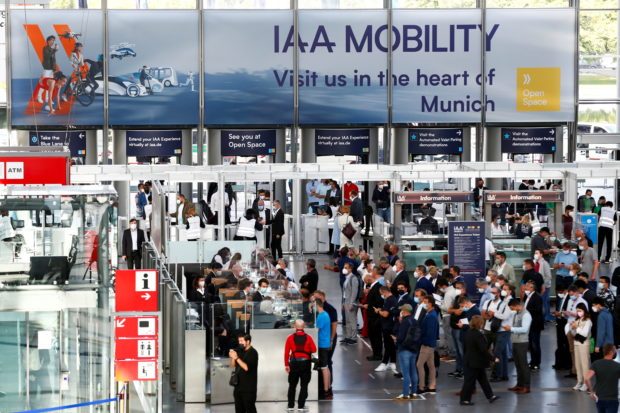
FILE PHOTO: People arrive for the Munich Auto Show, IAA Mobility 2021, in Munich, Germany, September 7, 2021. REUTERS/Michaela Rehle
BERLIN/MILAN — Sylvia Burbery is delighted that she no longer spends most of her life traveling for work.
“I am grateful that the pandemic has forced us to step back and look at ways of working we took for granted,” said the regional president for emerging markets at Mars petcare brand Royal Canin.
“I am very happy not to go back to spending 80% of my time traveling. I am not even sure it will be 50%,” Burbery said from her home office in Paris.
Burbery’s sentiments are echoed by workers around the world who are tired of the grind of corporate travel. This is bad news for the airlines, hotels and conference centers that rely on this lucrative business.
Mars, the family-owned snack and pet food company, said cost, environmental and health considerations were behind its decision to keep travel to less than half pre-pandemic levels, meaning 145,000 fewer flights per year.
Nici Bush, Mars global vice president for workplace transformation, said reducing travel could also make senior jobs more attractive to people with families.
She said 700 staff members could attend online strategy or sales events compared with the 100 people who used to meet in person: “You can really be more surgical about when you travel.”
Niklas Andreen, the chief operating officer of global corporate travel management firm CWT, knows the prospects are slim for a quick bounce back to pre-pandemic levels for the business travel sector.
While 58% of people polled by CWT say they are keen to resume expenses-paid junkets, bookings are only gradually recovering, with 80% of travel domestic now, compared with 67% pre-pandemic in 2019.
“It’s going to take several years before we’re back,” Andreen said.
In one of the first tests of the appetite of the business community for global gatherings, Germany’s auto show in Munich this week has seen many major car companies like Toyota and Jaguar’s Land Rover choosing to stay away.
German airline Lufthansa has nevertheless seen demand for its regional flights between Germany, Austria, Switzerland and Belgium jump 15% in recent weeks, and rise 30% for flights within Germany, Chief Executive Carsten Spohr said.
Lufthansa is putting on more flights for business travelers in September, but it only expects a return to 90% of pre-pandemic trips in the long term.
Counting the cost
Pre-pandemic, airlines made the bulk of their profits from business travel because companies are more likely to book at short notice and are prepared to pay more for convenient times.
U.S. spending on corporate travel is expected to only reach 25%–35% of 2019 levels by the fourth quarter of 2021, and 65%–80% a year later, according to a Deloitte survey of 150 travel managers.
“As companies look forward, they are thinking about how to keep some of the cost savings they have realized,” said Anthony Jackson, head of Deloitte’s U.S. aviation practice.
Italian fashion group Prada’s chief executive Patrizio Bertelli said he thinks business travel would be “reduced to a minimum”.
“This is certainly a big advantage for margins,” he said earlier this year.
Greener travel
Companies are also looking for ways to reduce their carbon footprint: about half the respondents in the Deloitte survey said they plan to adjust their business travel policy to decrease their environmental impact within the next year.
“I used to fly from Dallas to New York for the day for an internal meeting with three or four people. I don’t see that coming back very quickly,” Jackson said.
As part of climate measures Zurich Insurance Group unveiled this week, it said it would cut air travel compared to its pre-pandemic level by 70% as of 2022.
The consulting arm of CWT is helping companies design travel policies that balance cost with environmental impact, for example proposing the lowest cost direct flight rather than a cheaper indirect flight with higher carbon emissions.
Client care
However, CWT’s Andreen said it was still important for some managers to get staff, and clients, together again.
“It’s hard to close a deal without looking each other in the eye,” he said.
And Burbery said some face-to-face meetings remain better for brainstorming and resolving tensions between staff: “When you are virtual, you only see what people want you to see.”
Meeting clients is seen as the top reason though to resume travel, according to the Deloitte survey, while internal meetings and training are more likely to stay online.
Filippo Baldazzi, CEO of silk manufacturer Serica 1870 which works with Brunello Cucinelli, Kering and LVMH, sends samples of fabrics to customers he can’t visit in person.
“I hate video calls and clients like Vuitton and Gucci want to be pampered, they expect a white gloves type of treatment,” he said.